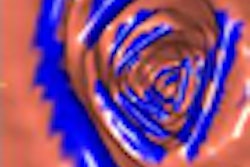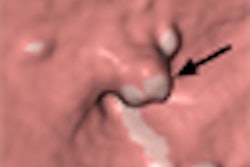BOSTON - Under the right conditions, FDG-PET/CT may become a very useful tool in detecting and evaluating coronary plaque, researchers from Washington University in St. Louis reported today at the American Society of Nuclear Cardiology (ASNC) meeting.
More than 50% of the plaques that lead to acute coronary syndrome are mild to moderate in severity. That characteristic makes it more difficult to detect the presence of these plaques through typical noninvasive imaging and intravascular ultrasound (IVUS).
In today's ASNC sessions, the researchers presented a proof-of-concept study that compared FDG-PET/CT with angiography and IVUS, as part of the association's Nuclear Cardiology Foundation and Pilot and Feasibility Awards.
'Costly, invasive'
In comparing the technologies, Dr. Peter M. Rao noted that the current gold standard for detecting the development of plaque along a vessel wall is coronary angiography. The procedure is essentially a lumenogram, he said, which detects plaque as it approaches the lumen. The advance in IVUS has allowed clinicians to look into the vessel wall to better understand the development of plaque and allow it to be evaluated.
However, angiography and IVUS "are both costly and invasive," Rao said. "So, the move is on to identify other potential targets for sensing vulnerable plaque."
One characteristic of vulnerable plaque is that it becomes inflamed, which ultimately leads to its own instability, thus causing coronary complications. Since FDG is a marker of metabolism, the imaging agent can detect the instability through uptake.
Rao acknowledged that some concerns exist with FDG-PET imaging, such as image resolution. It also is unclear how best to prepare a patient to optimize imaging, when is the best time to image after FDG injection, and how best to quantify vascular and myocardial uptake.
Glucose attraction
"The heart is an avid user of glucose when it is provided, and to evaluate the overlying pulmonary arteries would be impossible," Rao said. "However, observational studies of patients who presented for PET/CT imaging and received FDG have suggested that a significant portion -- up to 45% -- had coronary segments that were evaluated without seeing background activities, suggesting that perhaps, with modifications, FDG uptake of the myocardium could be improved."
Fasting prior to the exam may lessen the adverse effect of FDG uptake. So, one goal of the study was to determine how to suppress glucose uptake to allow for the evaluation of coronary arteries.
In selecting the study subjects, researchers did not include patients with coronary artery disease at the time of the angiography exam, or patients who had undergone percutaneous coronary intervention or coronary artery bypass graft. Those factors would increase inflammation and not reflect the true presence of plaque.
Patient demographics
The study reviewed eight of 10 patients, who had an average age of 56 and were split evenly between genders -- four men and four women. Six patients had images suitable for analysis; 80% of the patients had chest pain, and three patients had acute coronary syndrome.
Researchers found they were "fairly successful" in suppressing myocardial uptake with intralipid infusion and dietary introduction of fasting, Rao said. There also appeared to be a correlation of FDG uptake and plaque morphology. Imaging of coronary vascular uptake was optimal two to three hours after FDG injection.
Rao cited several limitations of the study, including the small sample size, which did not allow for significant statistical difference in the results. In addition, he noted that there was no control group, and researchers did not measure fatty acid levels at the time of imaging to determine if the fatty acids were elevated enough to suppress myocardial results.
By Wayne Forrest
AuntMinnie.com staff writer
September 12, 2008
Related Reading
Cedars-Sinai explores PET's future in nuclear cardiology, April 11, 2008
Coronary CTA's time is now, according to Dowe, January 17, 2008
New PET tracer may improve atherosclerotic imaging, November 15, 2007
Coronary CTA aids some asymptomatic patients, August 27, 2007
Gender differences seen in coronary plaque ruptures, August 21, 2007
Copyright © 2008 AuntMinnie.com




















